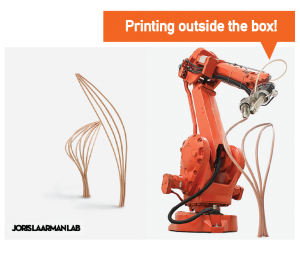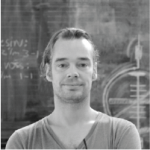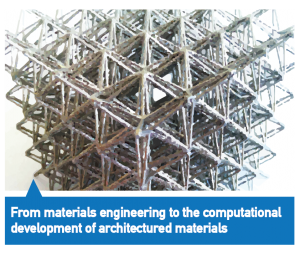Difference between revisions of "Msc3G5:Schedule"
(→LECTURE 2.0 0 MONDAY 17th NOVEMBER | 11:00 HRS | PROTOSPACE) |
|||
| Line 44: | Line 44: | ||
---- | ---- | ||
| + | |||
[[File:Wiki_lecture-09.png|right|150px|caption]] | [[File:Wiki_lecture-09.png|right|150px|caption]] | ||
'''BIO''' | '''Justin Dirrenberger''' is a materials scientist and Associate Professor of metallurgy at CNAM in Paris. In 2012, he completed a PhD thesis on the mechanics of architectured materials at Ecole des Mines de Paris. In 2013, he collaborated with EZCT Architecture & Design Research for Archilab, as a materials processing and structural engineering consultant. Recently, he initiated a graduate program on materials & additive manufacturing in Paris, open to both engineering and architecture students. He is leading the DEMOCRITE research project, funded by heSam Université, between CNAM, Arts et Métiers-ParisTech, ENSA Paris-Malaquais, ENSCI-Les Ateliers, and INRIA, aiming at developing additive manufacturing at the architectural scale. His research interests are related to the morphological structures of matter at different scales within materials. He is particularly involved in the design, modelling, simulation, optimisation, and processing of architectured materials, which result from the unholy alliance between metallurgy, mechanics, and geometry. | '''BIO''' | '''Justin Dirrenberger''' is a materials scientist and Associate Professor of metallurgy at CNAM in Paris. In 2012, he completed a PhD thesis on the mechanics of architectured materials at Ecole des Mines de Paris. In 2013, he collaborated with EZCT Architecture & Design Research for Archilab, as a materials processing and structural engineering consultant. Recently, he initiated a graduate program on materials & additive manufacturing in Paris, open to both engineering and architecture students. He is leading the DEMOCRITE research project, funded by heSam Université, between CNAM, Arts et Métiers-ParisTech, ENSA Paris-Malaquais, ENSCI-Les Ateliers, and INRIA, aiming at developing additive manufacturing at the architectural scale. His research interests are related to the morphological structures of matter at different scales within materials. He is particularly involved in the design, modelling, simulation, optimisation, and processing of architectured materials, which result from the unholy alliance between metallurgy, mechanics, and geometry. | ||
| − | + | ||
| + | |||
---- | ---- | ||
Revision as of 20:36, 26 October 2014
LECTURE 1.0 0 MONDAY 13th OCTOBER | 16:00 HRS | PROTOSPACE
Printing outside the box! | Tim Geurtjens | Joris Laarman Lab
Joris Laarman LAB is using 3D-printing techniques in most of their project. Sometimes just as a design tool, but increasingly also for actual functional prototypes. Frustration about the absurd high cost of 3D-printing and the lack of large enough building volumes led them to the development of the MX3D-program. MX3D stands for Multi Axis 3D Printing. By combining Industrial robots with different printing tools, they can now print large structures in many materials such as thermoset plastics or even Stainless steel and Aluminium.
BIO | After study mechanical engineering, Tim Geurtjens (1976) attended the Design Academy Eindhoven in 2003 where he graduated 4 years later. Since then he has been working as CTO for Joris Laarman Lab, best known for its experimental designs inspired by upcoming technology. Over the last 6 years he developed extensive knowledge of exotic materials and cutting edge technologies, specifically novel digital fabrication methods.
Tim is co-founder of MX3D, a company that developed several large-scale 3D printers that use 6-axis industrial robots. These printers allow them to print very large structures in many different materials such as thermoset plastics, stainless steel or aluminium.
LECTURE 2.0 0 MONDAY 17th NOVEMBER | 11:00 HRS | PROTOSPACE
From materials engineering to the computational development of architectured materials
Justin Dirrenberger | Department of Engineering Materials at CNAM, Paris
The classical engineering material-by-design approach has been extensively perfected by materials scientists, while engineers have been optimising structures geometrically for centuries. The purpose of architectured materials is to build bridges accross the microscale of materials and the macroscale of engineering structures, to put some geometry in the microstructure. This is a paradigm shift. Materials cannot be considered monolithic anymore. Any set of materials functions, even antagonistic ones, can be envisaged in the future. The development of architectured materials is involving materials scientists, metallurgists, chemists, physicists, mechanicians and engineers, but also biologists, computer scientists, architects, designers, mathematicians, plasticians, etc. In this presentation, we intend to demonstrate the necessity of computational means for developing architectured materials, especially using virtual material design, topology optimization and so-called "computational experiments".
BIO | Justin Dirrenberger is a materials scientist and Associate Professor of metallurgy at CNAM in Paris. In 2012, he completed a PhD thesis on the mechanics of architectured materials at Ecole des Mines de Paris. In 2013, he collaborated with EZCT Architecture & Design Research for Archilab, as a materials processing and structural engineering consultant. Recently, he initiated a graduate program on materials & additive manufacturing in Paris, open to both engineering and architecture students. He is leading the DEMOCRITE research project, funded by heSam Université, between CNAM, Arts et Métiers-ParisTech, ENSA Paris-Malaquais, ENSCI-Les Ateliers, and INRIA, aiming at developing additive manufacturing at the architectural scale. His research interests are related to the morphological structures of matter at different scales within materials. He is particularly involved in the design, modelling, simulation, optimisation, and processing of architectured materials, which result from the unholy alliance between metallurgy, mechanics, and geometry.




